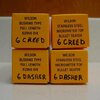forty_caliber
Member
Did some work with the new tooling for 6.5CM and my match grade ammo project. The main goal for now is to get best possible concentricity across a batch of cases during the sizing operation. The cases that I'm using are on their 3rd firing. I'm seeing some promising results using the concentricity gauge from web to ogive in the realm of .001 - .002
I've come up with kind of a process that seems to be working fairly well but thought I would run it by the membership for any input.
Forster Co-ax press
Body only full length size
Neck and shoulder with Forster neck bushing bump die
Mandrel for neck ID
This is basically separating the processes going on in a normal full length sizing die but with more control on the diameters of various case dimensions. Haven't shot any of these yet but the numbers look good.
.40
I've come up with kind of a process that seems to be working fairly well but thought I would run it by the membership for any input.
Forster Co-ax press
Body only full length size
Neck and shoulder with Forster neck bushing bump die
Mandrel for neck ID
This is basically separating the processes going on in a normal full length sizing die but with more control on the diameters of various case dimensions. Haven't shot any of these yet but the numbers look good.
.40



